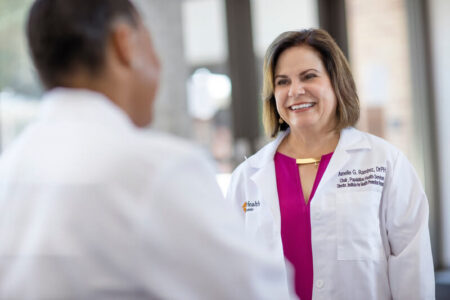
Share On Social!
Many healthcare facilities require healthcare staff to complete regular sensitivity trainings on competency, bedside manner, and similar topics.
These trainings can help providers deliver compassionate care for overlooked patients.
But, as more healthcare systems go the extra mile to create a non-medical drivers of health (NMDoH) screening program to care for patients’ non-medical needs, staff may need additional resources to guide conversations that are often deeply personal for some patients.
Here’s how healthcare staff can build rapport with patients and gain confidence in discussing NMDoH, from housing to income.
Put Yourself in the Patient’s Shoes
Think about your patient’s demographics.
What non-medical challenges to health do they face? What needs do they have?
Whether it’s income, food and housing insecurity, or lack of access to health insurance, these struggles can be difficult to discuss.
Certain patients may especially struggle to disclose needs if there is a lack of healthcare staff that don’t speak their language or don’t look like them.
That’s why Dr. Andrea Caracostis, executive director and CEO of HOPE Clinic in Houston, hires staff with patients’ background and language in mind.
“If you’re seeing a provider that looks like you and knows the same language, you’re able to form that trust a lot quicker,” she said.
You should also consider if patients would prefer to be screened for needs verbally or through a paper or electronic questionnaire, which may offer more privacy.
For example, at Nemours Children’s Health, NMDoH screening is completed via an electronic questionnaire in advance of medical appointments to help patients, families, and caregivers feel more comfortable answering potentially sensitive questions.
Completing the screening on a computer at the doctor’s office remains an option, but the preferred method is to complete the screening ahead of time in the Nemours app.
Show Respect to the Patient
You can also craft NMDoH screening questions to show patients you care about their privacy and acknowledge the sensitive nature of the screening topics.
For instance, at Nemours, two NMDoH screening questions proved vital for building trust between patients, families, and providers. These questions helped patients feel respected through the screening process – whether they accepted or declined help with addressing needs.

“The two vital questions are an opening and closing question that recognize the sensitivity of the questions we are asking,” said Kelly Thompson, director of population health management at Nemours. “The very first screening question is, ‘Are you willing to answer these questions?’ If that family says no, we respect that. A year later, they’ll be asked to complete the screening again, and maybe something has changed in that time. But we honor whatever the family or caregivers answer in the meantime.”
“At the end of the screening process, the final question is, ‘For any areas that you screened positive for needing help, are you interested in receiving help?’ Some families get to this question and think, ‘Yes, I shared with you my areas of need, but I don’t need help.’ Others say, ‘Yes, I want help.’”
“Those two questions have remained intact through the screening program’s development. They have been challenged at times as ‘extra questions’ that can be removed, but we haven’t removed them from the screening process because they provide sensitivity to the screening process for the families and promote a level of trust between them and the Nemours team.”
Similarly, Dr. Caracostis also emphasized that not all patients may want to participate in screening. If a patient declines to be screened for needs, HOPE Clinic nurses respect that decision.
And sometimes, it’s not always appropriate to initiate screening questions.
“If a patient is really sick, then you probably don’t want to ask them if they’re hungry,” Dr. Caracostis explained. “Our nurses are really good about using their judgment to avoid overwhelming patients with questions when their real concern is the bumping headache they have.”
Guiding Change with Compassionate Provider-Patient Communication
If patient seems open to conversation and addressing their needs, certain communication strategies can be helpful, such as motivational interviewing (MI).
MI is a “guiding style of communication” in which providers can empower patients to change and help them identify their capacity for change, according to the Motivational Interviewing Network of Trainers (MINT).
In other words, MI honors patient autonomy, which is important in building trust between the patient and provider.
When providers use MI for NMDoH screening, they engage with patients as their partner and do not give unsolicited advice, instruction, or warning.
“It is not a way to ‘get people to change’ or a set of techniques to impose on the conversation,” according to MINT. “MI takes time, practice and requires self-awareness and discipline from the clinician.”
Here are some resources that help put MI into practice in addressing needs:
- Mock Talk: Non-Medical Drivers of Health (Motivational Interviewing Case Study): This video by Activation Station examines a NMDoH screening phone conversation between a diabetes patient and a nurse. Viewers can learn how to make NMDoH screening conversations more conversational, collaborative, and empathic.
- Empathic Inquiry: Empathetic Inquiry is an approach to needs screening that is a combination of MI and informed care. Empathetic inquiry allows providers to relate to patients “from a place of non-judgmental curiosity and understanding,” according to the technique’s creators, the Oregon Primary Care Association (OPCA). Check out these downloadable implementation tools, including a conversation guide and observer checklist, which providers may find particularly helpful. You can also view a video example of an empathetic inquiry conversation with a patient.
- Interactive Webinar on Addressing NMDoH Using Motivational Interviewing Strategies: Beginning at timestamp 14:25, this webinar is particularly useful for navigating NMDoH screening conversations with children and teens. The webinar is generally helpful for having potentially sensitive discussions with patients of all ages. Examples in the webinar can be easily applied to the healthcare setting, including lessons in body language and question-framing to gain patient trust.
Learn more about NMDoH screening!
Learn how to identify the right person as screener for your NMDoH screening program!
Start Screening for the Non-Medical Drivers of Health (NMDoH)!
The non-medical drivers of health (NMDoH), like income, housing, and food, can influence health for better or worse.
That’s why we need to screen for the non-medical drivers of health.
NMDoH Screening means that a questionnaire is given to patients in a healthcare setting to help providers identify patient needs outside the healthcare setting. Patients can then be referred to helpful community resources.
Use the Salud America! Action Pack, “How to Screen for NMDoH in Healthcare,” to develop a screening program in your clinic, hospital, or healthcare system.
The action pack, developed by Dr. Amelie G. Ramirez at UT Health San Antonio, has a conversation-starting model email, fact sheet, checklist on how to develop screening, and a guide on existing screening tools for NMDoH.
An Essential Tool in Healthcare
NMDoH screening has the power to address a variety of health-related needs for Latinos and all people, said Dr. Amelie Ramirez, director of Salud America! and its home base, the Institute for Health Promotion Research at UT Health San Antonio.
“Health is far more than what can be provided in a doctor’s office,” Dr. Ramirez said. “In the same way that a team of doctors develops a patient treatment plan to treat cancer, a team of doctors and community services should develop a patient treatment plan that includes addressing needs and their root causes.”
You can help promote NMDoH screening and health improvement, too.
Select your county and get a Health Report Card by Salud America! at UT Health San Antonio.
In your Report Card, you will see maps, data, and gauges to compare public health issues to the rest of your state and nation.
You can email your Health Report Card to local leaders to stimulate community change. Use the data in your materials or share on social media to raise awareness about the importance of NMDoH screening.
Explore More:
Increasing RecognitionBy The Numbers
3
Big Excuses
people use to justify discriminatory behavior



